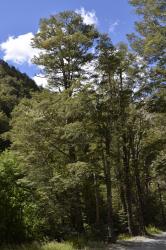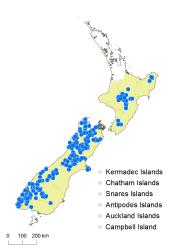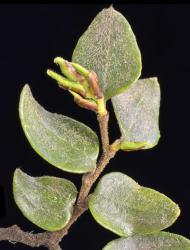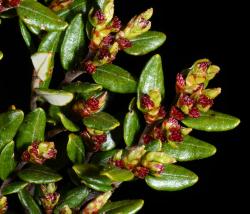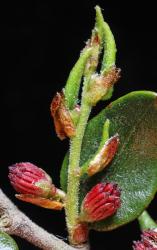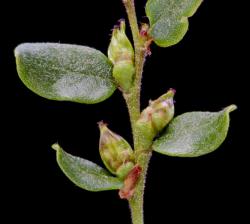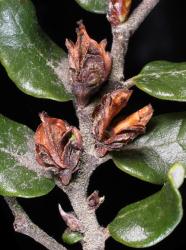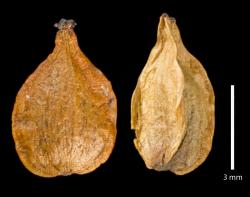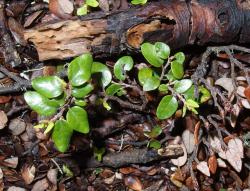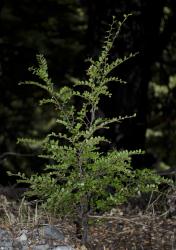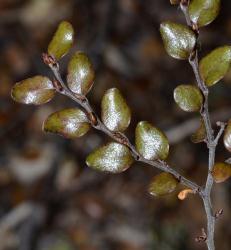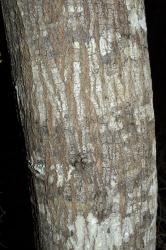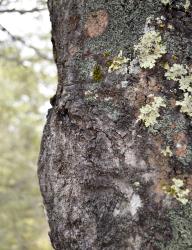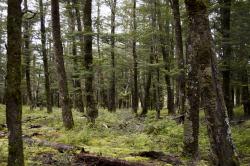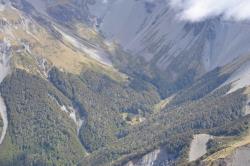- Taxon
- Gallery
- ≡ Fagus cliffortioides Hook.f., Icon. Pl. 7, 673 (1844)
- ≡ Nothofagus cliffortioides (Hook.f.) Oerst., Kongel. Danske Vidensk. Selsk. Skr., Naturvidensk. Math. Afd. 9: 355 (1871)
- ≡ Nothofagus solandri var. cliffortioides (Hook.f.) Poole, Trans. Roy. Soc. New Zealand 85: 563 (1958)
Prostrate to erect shrub to medium-sized tree, (0.45–)12–15(–25) m high; trunk short-boled and multi-stemmed or straight cylindrical, 0.5–0.75(–1) m diameter, not buttressed or flanged; crown spreading. Young branchlets terete, grooved, grey, brown or red-brown, with whitish pubescence. Stipules caducous, non-peltate, 2–3.5 mm long, oblong-oblanceolate to oblong-ovate. Leaf lamina, 4–16 × 3.5–9 mm, ovate or triangular-ovate, coriaceous, veins indistinct, domatia absent; adaxially glossy green, glabrescent; abaxially grey-green to white, tomentose; margin entire, glabrous; apex acute to subacute, often inflexed, sometimes apiculate; base oblique; petiole 0.5–2 mm long, pubescent, sometimes pilose. Staminate inflorescences 2–4(–5)/branchlet, sessile or pedunculate to 2.0 mm long, 1 or 2 (rarely 3) flowers/dichasium, sessile to shortly pedicellate; perianth shallowly campanulate, asymmetic, 1.5–3 mm long, glabrous, green, shallowly and obtusely 3- or 4-lobed (rarely 5-lobed), margin glabrous. Stamens 7–16; filaments 1.0–3 mm long, glabrous; anthers 1.5–2.5 mm long, glabrous, dark red. Pistillate inflorescences 1 or 2/ branchlet, sessile; dichasium ovoid with (1–)2(–3) sessile flowers/cupule, trimerous and dimerous, glabrous or sparsely hairy, one trimerous flower often missing or atrophied in a 2- or 3-flowered dichasium. Mature cupule, 3–6 mm long; valves 2 or 3(rarely 4), even or uneven in length, narrow-triangular, coriaceous, pilose below or with scattered short hairs, acute; lamellae (1–)2/valve, acute. Nut 4–6 × 2.5–3.5 mm, triquetrous or lenticular, glabrous or sparsely pubescent, red-brown or brown.
Bark and wood: Bark on young trees smooth, thin, light grey to grey; bark on old trees rough and finely furrowed, grey to dark grey. Sapwood white to yellow-white when fresh, usually paler than that of Fuscospora solandri; heartwood black-brown or light brown when fresh.
Juvenile leaves: Often smaller than adult leaves, leaves ovate to suborbicular, with obtuse apices.
Species rank was adopted for mountain beech by Heenan & Smissen (2013). They considered that mountain and black beech occur in sympatry over a wide area of the North and South Islands, have differentiated habitats, and can be distinguished by their morphology. Smissen et al. (2014) showed from DNA profiles that they are also genetically distinct although with considerable admixture at some locations. They hypothesised that they have arisen in allopatry and are in secondary contact showing hybridisation and probably introgression.
Distinguished from most other species of southern beech, except for Fuscospora solandri, by an entire leaf margin. Separated from F. solandri by an ovate to triangular-ovate lamina tapered to an oblique base and a subacute to acute apex versus a more oblong-elliptic to ovate lamina tapered equally to the base and an obtuse apex. Fuscospora cliffortioides is often more thickly white-tomentose on the underside of the lamina and more sparsely pilose on the cupule and flower than F. solandri.
North Island: South Auckland (Raukūmara Range, Urewera National Park, Hauhungaroa Range, Kaimanawa Range, Kaweka Range), Volcanic Plateau, Wellington (Ruahine Range, northern Tararua Range).
South Island: Nelson, Marlborough, Westland, Canterbury, Otago, Southland, Fiordland.
Altitudinal range, sea level–1550 m a.s.l. (at Mt Whanokao, Raukūmara Range). Montane to sub-alpine forest and shrubland. Found in extensive pure stands in the upper montane to subalpine zones, often in association with Lophozonia menziesii; becoming dominant with increasing altitude and decreasing moisture, drainage and fertility; often forming the treeline as a small tree or shrub. At lower latitudes, especially in the southern parts of its range, found at sea level at sites with low fertility and impeded drainage.
Flowering: Nov.–Jan. (mast seeding)



